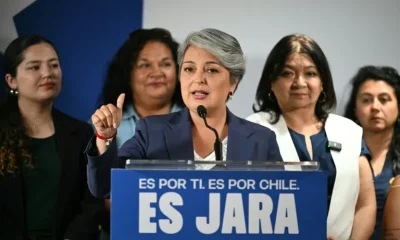International
‘Green cards’ for undocumented spouses of Americans: “A hope for many”

María Villanueva and Gustavo Villeda met in 2019 in a church in Silver Spring, a suburb north of the capital of the United States, and although they fell in love and started dating, she was reluctant to marry him because she did not want to “suffer” for a reality that was already familiar to her.
Villeda, born in Guatemala, emigrated to the United States in 2004 irregularly and it is this status – which he has not been able to adjust – that made Villanueva, a Mexican with American nationality, doubt about whether or not to go through the altar.
Today, not only do they live together and got married last summer, but they have a two-month-old child in common.
“I said that I was never going to marry someone who didn’t have papers, out of fear and the anguish that they might separate us,” the 32-year-old explains laughing in an interview with EFE from the dining room of her house in the small town of Laurel (Maryland).
She left Mexico at just 7 years old to reunite with her father – who already lived in the United States – while her husband emigrated as an adult with the expectations that the ‘American dream’ would allow her to send money to a sick daughter she left in Guatemala and who is about to turn 20.
“I haven’t seen her grow up and I don’t want this to happen to me again with him,” he says, looking at his son Alfonso Jesús, who sleeps next to him in the mother’s arms. Both are sitting on the sofa in the living room, presided over by a set of photographs of their wedding hanging on the wall and visible as soon as they enter the small house.
The couple agrees that, once married, the great impediment to trying to fix Gustavo’s papers has been the economic factor. “I suffer from severe migraine, we have needed the money for doctors and we have not been able to allocate it to the (regularization) application,” says María.
But now the situation of uncertainty of this family can change because Villeda is one of the more than half a million migrants eligible to take advantage of the new program, announced last Tuesday by the Government of President Joe Biden, and thus regularize their status in the country.
The measures mainly benefit people married to U.S. citizens – a condition that he fulfills – who will be able to take the first step in the process to obtain a residence permit in the United States.
Gustavo, still assimilating the new opportunity that has been presented to him, assures that the news has reached him “by surprise” and, although he does not know in detail how the process continues, he is optimistic to have “a hope for many” in front of him.
Supported by a legal figure known as ‘parole’, this permit grants those who are already in US territory protection against deportation and allows them to apply for a work permit.
With the labor authorization, which will be valid for three years, migrants who entered the country irregularly and are married to U.S. citizens can apply for residence and, subsequently, citizenship.
To benefit from this formula, the person must have married a U.S. citizen before June 17, 2024 and have lived in the country for at least 10 years.
At the same time, months after this announcement enters into force, the couple does not overlook the fact that next November there will be presidential elections in the country that can change everything.
“We are concerned that all this may come to nothing, that it may be spoiled by a change of government or by disputes between them,” says María, questioning the presumptuous presidential candidates – Joe Biden and Donald Trump-, although she is convinced to “take the risks” and to take advantage of these months before the elections.
“We hope that you respect the families who, like us, are going through this situation and who have been fighting for a reform,” adds the woman, who is a collaborator of CASA, an NGO for defense and assistance to immigration.
Even with all the difficulties in mind, the two agree that there is hope and they are willing to keep looking for it.
International
El Chapo’s son Joaquín Guzmán López pleads guilty to U.S. drug trafficking charges

Joaquín Guzmán López, one of the sons of notorious Mexican drug lord Joaquín “El Chapo” Guzmán, pleaded guilty on Monday to drug trafficking charges in a U.S. court, months after his brother Ovidio reached a similar plea agreement, according to local media reports.
The defendant appeared before a federal court in Chicago early Monday afternoon and changed his previous plea in the case, the Chicago Tribune reported. U.S. authorities accuse him of forming, together with his three brothers, the cartel faction known as “Los Chapitos.”
The group is believed to have continued the operations of El Chapo, who has been serving a life sentence in the United States since 2019.
Guzmán López, 39, was arrested after landing in Texas in a small aircraft alongside cartel co-founder Ismael “El Mayo” Zambada.
International
Venezuela authorizes return flights as U.S. continues deportations amid rising tensions

The arrival of U.S. aircraft carrying undocumented Venezuelan migrants continued regularly despite rising tensions between Washington and Caracas over President Donald Trump’s military deployment in the Caribbean.
Trump maintains that the deployment is part of an anti-narcotics operation, while Venezuelan President Nicolás Maduro insists the true objective is to remove him from power and seize the nation’s oil resources.
Venezuela’s aviation authority has “received a request from the United States government to resume repatriation flights for Venezuelan migrants from that country to Venezuela,” the Ministry of Transportation said in a statement .
“Under the instructions of President Nicolás Maduro, authorization has been granted for these aircraft to enter our airspace,” it added.
Caracas will permit two Eastern Airlines flights to land on Wednesday and Friday.
Migration remains one of the Trump administration’s flagship issues. On Monday, the U.S. president held a meeting with his National Security Council to discuss the situation in Venezuela, a day after confirming he had spoken with Maduro by phone, without offering further details.
According to the Venezuelan government, roughly 75 deportation flights have been carried out this year, returning at least 13,956 Venezuelans from the United States.
International
20,000 rounds stolen from german army after driver leaves cargo unattended

The German army confirmed the theft of a shipment of ammunition that occurred a week ago while it was being transported by a civilian delivery driver, a military spokesperson told AFP, confirming earlier media reports.
According to Der Spiegel and the regional broadcaster MDR, around 20,000 rounds of ammunition were stolen from an unguarded parking lot near Magdeburg, in eastern Germany, while the driver was asleep in a nearby hotel. No information has been released regarding the identity of the suspects, and the military declined to specify the exact type or amount of ammunition taken.
Authorities have also not indicated how the perpetrators knew the cargo would be left unattended.
“The theft was discovered upon delivery at the barracks,” the German army spokesperson said.
A police spokeswoman confirmed to AFP that an investigation has been opened but refused to provide further details “for tactical reasons.”
Sources close to the German military, cited by Der Spiegel, believe it is unlikely the theft was a coincidence. They suspect the thieves waited for the driver to stop for the night before striking.
Der Spiegel also reported that the Defense Ministry normally requires two drivers for this type of transport to ensure the cargo is constantly monitored. However, in this case only one driver was assigned, meaning the civilian transport company failed to comply with the security protocols.
-

 Central America4 days ago
Central America4 days agoTrump Pardons Former Honduran President Hernández and Warns of Aid Cuts Ahead of Election
-

 Central America2 days ago
Central America2 days agoHonduras Extends Voting by One Hour Amid High Turnout, CNE Announces
-

 Central America3 days ago
Central America3 days agoHonduras’ China–Taiwan Future Hinges on Sunday’s Presidential Election
-

 International2 days ago
International2 days agoHong Kong police arrest 13 over deadly high-rise fire that killed 151
-

 International4 days ago
International4 days agoMeta Says Russia Seeks to Ban WhatsApp for Defending Secure Communication
-

 International2 days ago
International2 days agoSri Lanka and Indonesia deploy military as deadly asian floods kill over 1,000
-

 International2 days ago
International2 days agoTrump says asylum decision freeze will remain in place “for a long time”
-

 International2 days ago
International2 days agoChile enters runoff campaign with Kast leading and Jara seeking a last-minute comeback
-

 International12 hours ago
International12 hours ago20,000 rounds stolen from german army after driver leaves cargo unattended
-

 International12 hours ago
International12 hours agoVenezuela authorizes return flights as U.S. continues deportations amid rising tensions
-

 International12 hours ago
International12 hours agoEl Chapo’s son Joaquín Guzmán López pleads guilty to U.S. drug trafficking charges
-

 International12 hours ago
International12 hours agoTrump convenes National Security Council as U.S.–Venezuela tensions intensify






























